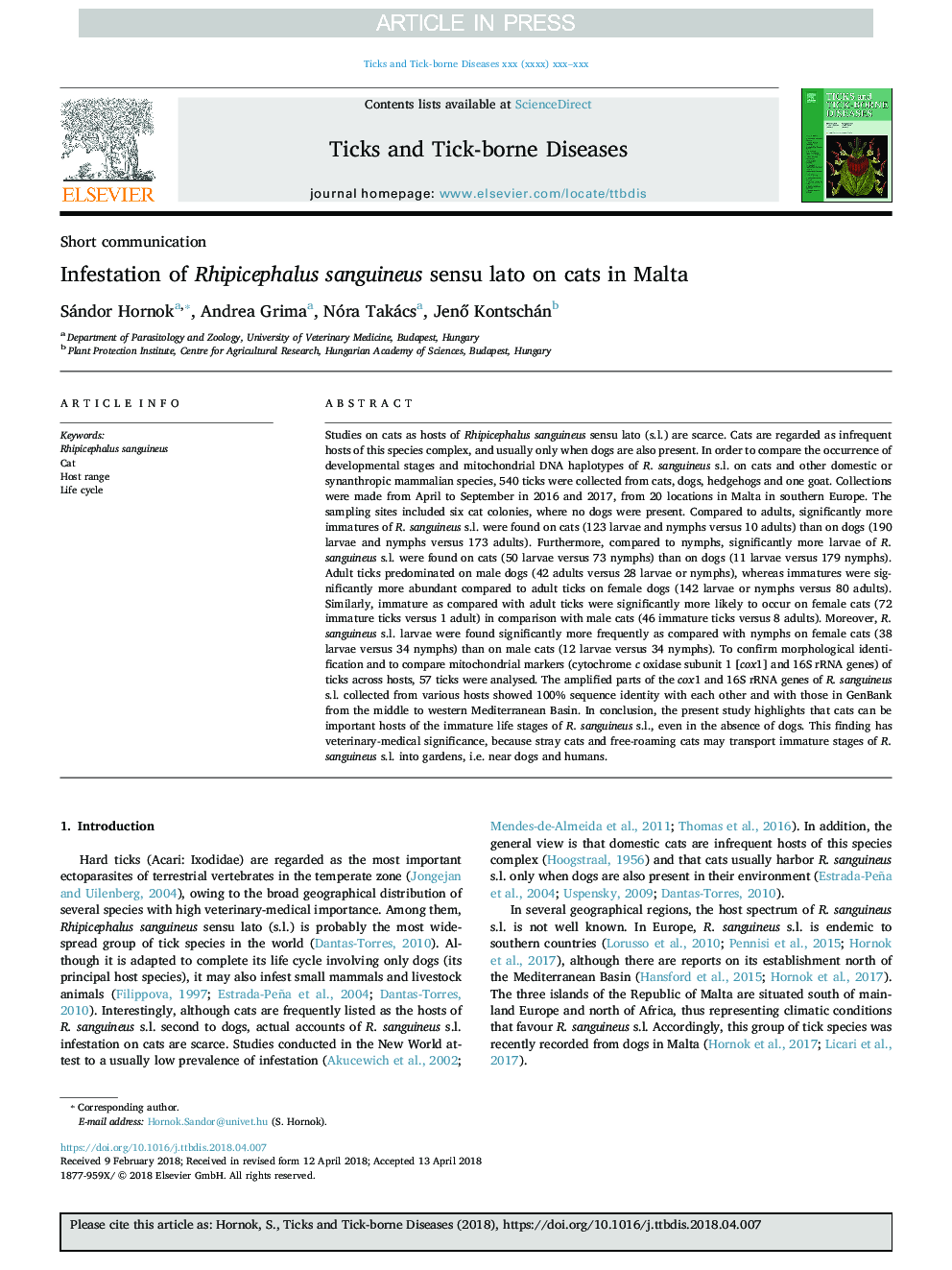| کد مقاله | کد نشریه | سال انتشار | مقاله انگلیسی | نسخه تمام متن |
|---|---|---|---|---|
| 8506995 | 1555959 | 2018 | 5 صفحه PDF | دانلود رایگان |
عنوان انگلیسی مقاله ISI
Infestation of Rhipicephalus sanguineus sensu lato on cats in Malta
دانلود مقاله + سفارش ترجمه
دانلود مقاله ISI انگلیسی
رایگان برای ایرانیان
موضوعات مرتبط
علوم زیستی و بیوفناوری
علوم کشاورزی و بیولوژیک
علوم دامی و جانورشناسی
پیش نمایش صفحه اول مقاله

چکیده انگلیسی
Studies on cats as hosts of Rhipicephalus sanguineus sensu lato (s.l.) are scarce. Cats are regarded as infrequent hosts of this species complex, and usually only when dogs are also present. In order to compare the occurrence of developmental stages and mitochondrial DNA haplotypes of R. sanguineus s.l. on cats and other domestic or synanthropic mammalian species, 540 ticks were collected from cats, dogs, hedgehogs and one goat. Collections were made from April to September in 2016 and 2017, from 20 locations in Malta in southern Europe. The sampling sites included six cat colonies, where no dogs were present. Compared to adults, significantly more immatures of R. sanguineus s.l. were found on cats (123 larvae and nymphs versus 10 adults) than on dogs (190 larvae and nymphs versus 173 adults). Furthermore, compared to nymphs, significantly more larvae of R. sanguineus s.l. were found on cats (50 larvae versus 73 nymphs) than on dogs (11 larvae versus 179 nymphs). Adult ticks predominated on male dogs (42 adults versus 28 larvae or nymphs), whereas immatures were significantly more abundant compared to adult ticks on female dogs (142 larvae or nymphs versus 80 adults). Similarly, immature as compared with adult ticks were significantly more likely to occur on female cats (72 immature ticks versus 1 adult) in comparison with male cats (46 immature ticks versus 8 adults). Moreover, R. sanguineus s.l. larvae were found significantly more frequently as compared with nymphs on female cats (38 larvae versus 34 nymphs) than on male cats (12 larvae versus 34 nymphs). To confirm morphological identification and to compare mitochondrial markers (cytochrome c oxidase subunit 1 [cox1] and 16S rRNA genes) of ticks across hosts, 57 ticks were analysed. The amplified parts of the cox1 and 16S rRNA genes of R. sanguineus s.l. collected from various hosts showed 100% sequence identity with each other and with those in GenBank from the middle to western Mediterranean Basin. In conclusion, the present study highlights that cats can be important hosts of the immature life stages of R. sanguineus s.l., even in the absence of dogs. This finding has veterinary-medical significance, because stray cats and free-roaming cats may transport immature stages of R. sanguineus s.l. into gardens, i.e. near dogs and humans.
ناشر
Database: Elsevier - ScienceDirect (ساینس دایرکت)
Journal: Ticks and Tick-borne Diseases - Volume 9, Issue 5, July 2018, Pages 1120-1124
Journal: Ticks and Tick-borne Diseases - Volume 9, Issue 5, July 2018, Pages 1120-1124
نویسندگان
Sándor Hornok, Andrea Grima, Nóra Takács, JenÅ Kontschán,